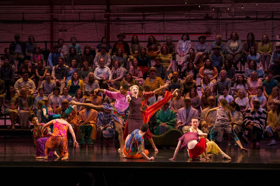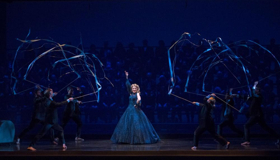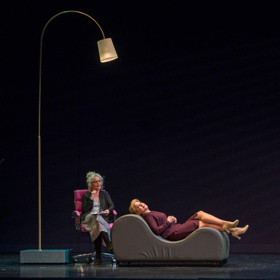Review: LADY IN THE DARK a Walk on the Weill Side with MasterVoices and Victoria Clark at City Center

The line between Broadway-type musical theatre and opera becomes finer by the year--though I dare say that TOOTSIE is unlikely to be showing up at the Met any time soon. But the Kurt Weill-Ira Gershwin-Moss Hart LADY IN THE DARK might have morphed in a slightly different, better piece of music theatre if it arrived in the 21st century rather than World War II.
As it was presented last weekend at New York's City Center by the MasterVoices chorus under Ted Sperling, who also conducted the Orchestra of St. Luke's as well as directed the production, with the splendid Victoria Clark as the indecisive main character, magazine editor Liza Elliott, LADY is an edgy musical piece about psychoanalysis. (Amy Irving plays the analyst, a nonsinging role.) It had extended dream sequences--staged very well at City Center, with choreography by Doug Varone whose dancers helped visualize Liza's angst--and "book" scenes that were not as successful, even with such good performers as Ashley Park and Montego Glover as Liza's minions..

In short, it was an ambitious, noteworthy production--with scenic design by Doug Fitch, costumes by Tracy Christensen, lighting by James Ingalls and sound design by Scott Lehrer--that showed off some terrific performers, excellent vocal work from the 120 member MasterVoices chorus (which also did quite nicely in some scene-work) and a zippy performance by the St. Luke's musicians. Sperling was at his best with the orchestra, though he wasn't nearly as sure with the overall pacing of the show.
Despite its success in 1941, with musical star Gertrude Lawrence (of, later, THE KING AND I fame) as Liza, one had the feeling that LADY IN THE DARK couldn't work as well today as when it was new: The subject simply isn't as shocking today as it was to audiences in 1941, when not everyone and her brother had a shrink. The original creative team behind it--the score by Weill and Gershwin, who weren't strangers to the opera stage, book and direction by Hart--might have been more at home on today's opera stages than many of their Broadway peers and produced a different kind of piece.

Weill wrote an interesting score, in his Broadway musical period, with echoes of THREEPENNY OPERA popping up at unexpected moments. One of the show's best known songs is "My Ship," which is used as a leitmotif from the first moments of the overture but doesn't become fully realized until the very end of the show, in a lovely performance by Clark. In fact, for me at least, the show's best songs are all in the Circus Dream sequence, and, at that, at the very end of the production.
In addition to "My Ship," there was Clark in the fabulous "The Saga of Jenny" (which synthesizes Liza's inability to make up her mind, whether about which man to bed or what theme to use on her magazine cover) and a notable comic number, the tongue-twisting "Tschaikowsky [sic]." It was done neatly by David Pittu, just missing some of the daredevil pyrotechnics that made Danny Kaye a star in the original.
Weill, of course, is best known in opera houses for THE RISE AND FALL OF THE CITY OF MAHAGONNY (AUFSTIEG UND FALL DER STADT MAHAGONNY)--the 1930 collaboration with Bertolt Brecht, which was a hit in the late '70s at the Met with Teresa Stratas and, more recently, in a 2007 LA Opera production with Audra MacDonald and Patti Lupone that was recorded live. (There was also Weill's STREET SCENE from 1947, written with Langston Hughes, which the composer called an "American opera," though it started life on Broadway.)
MAHAGONNY (not to be confused with Diana Ross's MAHOGANY) had its belated American debut off-Broadway in 1970, directed by Carmen Capalbo, who had led the off-Broadway production of THREEPENNY OPERA to major success. MAHAGONNY, starring Broadway musical comedy darling Barbara Harris and Estelle Parsons, was far from a hit, with much recasting and changes through long weeks of previews, as they tried to remake it in a Broadway musical mode.
Gershwin was well known as collaborator with his brother George, in the Broadway musical arena, but already had PORGY AND BESS under his belt by the time he worked on LADY (thought PORGY took years to prove itself opera-house-worthy). In LADY, he showed his deft use of language to help Weill's score take flight.
Hart was a well-known director (the original MY FAIR LADY) and playwright, best known for his collaborations with George F. Kaufman, including THE MAN WHO CAME TO DINNER (but less successful in more dramatic material). Perhaps that's why his book passages are jokey in the HIS GIRL FRIDAY (the Cary Grant-Rosalind Russell version of THE FRONT PAGE) manner, which came out the year before, or dull-ish in the more serious scenes, with Liza's various love interests, played by Ron Raines, Ben Davis and Christopher Innvar.
The MasterVoices performances premiered a new edition of the score and book, though it surely hewed fairly closely to the original; the score was performed uncut (seeming even larger with the addition of the chorus's formidable work), with the script edited by Hart's son, Christopher, and Kim Kowalke. (Hart's widow, Kitty Carlisle Hart, was well known as keeper of his flame, watching carefully over his legacy, so it's unlikely that much editing was done to LADY's book.)
All in all, this LADY gave us a much better look at Weill's score--with so much to admire--than the last revival, done early in the history of City Center's ENCORES! Series, with Christine Ebersole. But despite any misgivings, particularly about the book, I don't think we've seen the last of it.
Reader Reviews
Videos

